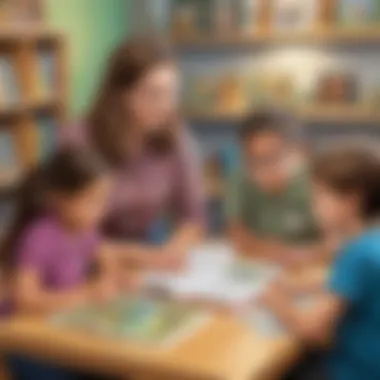Enhancing Learning Through Problem-Based Learning: Examples and Applications


Creative Activities
In the realm of problem-based learning, creative activities play a pivotal role in engaging students and fostering critical thinking. Encouraging children to think outside the box, these activities aim to inspire innovative solutions and collaboration among peers. Through engaging in hands-on projects and thought-provoking tasks, students not only enhance their problem-solving skills but also develop a deeper understanding of complex concepts. From designing sustainable cities to creating intricate Rube Goldberg machines, these activities not only nurture creativity but also instill a sense of accomplishment and teamwork among participants.
Fun Quizzes
Complementing the problem-based learning approach, fun quizzes offer an interactive way to assess students' understanding and knowledge retention. Covering a myriad of topics ranging from science and mathematics to literature and history, these quizzes pique children's interest and reinforce key concepts. By incorporating diverse question types such as multiple-choice, truefalse, and fill-in-the-blank, quizzes promote active learning and critical thinking skills. Moreover, the instant feedback provided by these quizzes serves as a tool for continuous improvement, motivating students to delve deeper into their studies and broaden their intellectual horizons.
Fact-Based Articles
In the educational landscape of problem-based learning, fact-based articles serve as valuable resources for students seeking in-depth knowledge on various subjects. Covering a wide array of topics, these articles are crafted to be engaging, informative, and easily digestible for young readers. By presenting complex information in a clear and concise manner, these articles stimulate curiosity and encourage further exploration. Additionally, by including links to supplementary resources, students are empowered to conduct independent research and expand their understanding beyond the confines of the classroom.
Introduction to Problem-Based Learning
In the realm of education, Problem-Based Learning (PBL) stands out as a dynamic approach that nurtures critical thinking, collaboration, and real-world application. This article delves into the significance of PBL, shedding light on how it can transform the learning experience. By emphasizing active engagement and practical problem-solving, PBL equips students with the skills necessary for success in an ever-evolving world. Understanding the core elements and benefits of PBL is crucial for educators and learners seeking to enhance their educational journey.
Defining Problem-Based Learning
Overview of PBL methodology -
When dissecting the Overview of PBL methodology, we uncover a structured approach that centers on problem-solving as the focal point of learning. This methodology shifts the traditional classroom dynamics by placing students at the helm of their learning process. By engaging in real-world problems, students develop not only subject-specific knowledge but also crucial skills such as critical thinking, collaboration, and communication. This participatory approach to learning enhances learner autonomy and fosters a deeper understanding of the subject matter, making it a preferred choice in modern educational settings.
Core principles of PBL -
The Core principles of PBL highlight the fundamental philosophies that underpin this innovative learning approach. Fostering student-centered learning and inquiry, PBL encourages learners to explore complex problems, break them down into manageable parts, and work collaboratively to reach solutions. This principle emphasizes active participation, self-directed learning, and the application of theoretical knowledge in practical scenarios. While the core principles of PBL empower students to take charge of their learning journey, challenges such as facilitating effective group dynamics and managing diverse learning styles need addressing for optimal implementation.
Benefits of Problem-Based Learning
Enhanced critical thinking skills -


Enhanced critical thinking skills lie at the core of PBL's benefits, enriching students with the ability to analyze, evaluate, and solve intricate problems effectively. By engaging in hands-on problem-solving activities, students develop the capacity to think critically, make informed decisions, and approach challenges from multiple perspectives. This heightened cognitive ability not only aids academic success but also cultivates life skills essential for navigating complexities beyond the classroom.
Promotion of teamwork and collaboration -
Promotion of teamwork and collaboration emerges as a pivotal benefit of PBL, fostering an environment where students learn to collaborate, communicate, and empathize with their peers. Through collaborative projects and group discussions, learners enhance their interpersonal skills, strengthen their ability to work in teams, and appreciate diverse viewpoints. This collaborative spirit nurtured by PBL prepares students for future professional endeavors and equips them with the soft skills necessary for success in a team-oriented society.
Implementing Problem-Based Learning in Elementary Education
As we delve into Utilizing Problem-Based Learning, it is essential to emphasize its application in elementary education. Implementing Problem-Based Learning in elementary education is crucial for developing critical thinking skills and fostering collaboration among young minds. By integrating PBL into the elementary curriculum, students are encouraged to think creatively, analyze information, and work collectively towards solutions. This approach not only enhances academic learning but also prepares students for real-world challenges they may encounter in the future.
Examples of PBL in Elementary Curriculum
Case studies in science and math
Exploring case studies in science and math within the realm of PBL provides students with practical application of theoretical concepts. By immersing themselves in real-world scenarios, students enhance their problem-solving skills and analytical thinking. Case studies offer a glimpse into addressing complex issues using scientific methods or mathematical principles, making learning interactive and engaging for young learners.
Solving real-world community issues
Addressing real-world community issues through PBL empowers students to apply their knowledge beyond the classroom. By identifying problems within their community, students learn to research, collaborate, and propose solutions, instilling a sense of social responsibility. This hands-on approach not only sharpens their cognitive abilities but also nurtures empathy and active citizenship among elementary learners.
Adapting PBL for Different Learning Styles
When considering the diversity of learning styles, adapting PBL becomes imperative to cater to individual needs effectively. Recognizing visual learners, who comprehend information best through visual aids, allows educators to incorporate graphs, charts, or videos to enhance their understanding. Similarly, accommodating kinesthetic learners, who thrive on hands-on experiences, involves integrating activities that involve movement or tactile interaction, enriching their learning experience and retention of knowledge.
Integrating Technology with Problem-Based Learning (300-400 words):
In this crucial section on integrating technology with problem-based learning, we delve into the significant role of technology in enhancing the educational process. The infusion of technology in education is paramount as it opens up a plethora of possibilities for interactive and engaging learning environments. By seamlessly blending technology with problem-based learning, students are exposed to a more dynamic and immersive educational experience. The evolution of educational technology has revolutionized traditional teaching methods, catering to the diverse learning styles and preferences of students across different age groups.
Digital Tools for PBL Engagement (at least 250-300 words):


Online platforms for collaborative projects:
Online platforms for collaborative projects serve as virtual spaces where students can collaborate, engage, and interact in real-time on shared assignments. The seamless integration of digital platforms into problem-based learning environments fosters a sense of community and teamwork among students, transcending physical boundaries. The unique feature of these platforms lies in their ability to facilitate synchronous and asynchronous communication, allowing for flexibility and engagement outside of traditional classroom settings.
Virtual simulations for hands-on learning:
Virtual simulations for hands-on learning provide a simulated environment where students can actively engage with complex concepts in a risk-free setting. The key characteristic of virtual simulations is the hands-on experiential learning they offer, allowing students to experiment, make mistakes, and learn from their experiences in a controlled digital environment. While virtual simulations enhance student understanding and retention of content, they may present challenges in replicating the tactile and sensory experiences of real-world scenarios.
Challenges and Solutions in Tech-Driven PBL (at least 250-300 words):
Access to technology resources:
Access to technology resources plays a pivotal role in the successful implementation of tech-driven problem-based learning. Equitable access to devices, internet connectivity, and digital tools is essential to ensure all students have equal opportunities to engage in technology-enhanced learning experiences. The key characteristic of addressing access challenges is promoting inclusive practices that bridge the digital divide and provide support for underserved student populations.
Digital literacy skills development:
Digital literacy skills development focuses on empowering students with the necessary competencies to navigate, evaluate, and utilize digital tools effectively. By honing digital literacy skills, students can critically assess information, collaborate on digital platforms, and engage responsibly in online activities. The unique feature of digital literacy skills development is its emphasis on enabling students to become not just consumers but creators of digital content, preparing them for success in a technology-driven world.
Assessment and Evaluation in Problem-Based Learning
Assessment and Evaluation in Problem-Based Learning play a crucial role in gauging student progress and the effectiveness of the teaching approach. It involves measuring the learning outcomes achieved through Problem-Based Learning (PBL). By assessing student performance, educators can identify strengths and areas needing improvement to tailor instruction accordingly. Evaluation in PBL goes beyond traditional testing methods, focusing on critical thinking, problem-solving skills, and collaboration.
Measuring Learning Outcomes
Rubric-based Assessment
Rubric-based assessment is a structured method of evaluating student work based on predetermined criteria. It provides clear guidelines for what constitutes success in a given task, allowing for consistent and fair evaluation. The key characteristic of rubric-based assessment lies in its objectivity and transparency, offering students a clear understanding of expectations. This approach is favored in PBL as it aligns with promoting self-directed learning and provides detailed feedback for continual improvement. However, one disadvantage is the time-intensive nature of creating and applying rubrics, requiring careful planning and calibration to ensure accuracy.
Peer Evaluation


Peer evaluation involves students providing feedback on their peers' work, fostering accountability and shared learning. It encourages students to consider alternative perspectives and develop communication skills. The key characteristic of peer evaluation is its peer-to-peer feedback mechanism, promoting a collaborative learning environment. In PBL, peer evaluation enhances teamwork and allows students to learn from each other's strengths and challenges. Yet, challenges may arise concerning the reliability of peer feedback and the need for clear assessment criteria to guide evaluations.
Addressing Challenges in PBL Assessment
Subjectivity in Assessment
Subjectivity in assessment refers to the potential bias or personal interpretation affecting evaluative judgments. While subjectivity allows for holistic assessment, it can introduce inconsistencies and lack objectivity. In the context of PBL, subjectivity can be advantageous by capturing the overall learning experience and growth beyond rigid criteria. However, mitigating subjectivity through clear assessment guidelines and calibration is essential to ensure fairness and reliability of assessments.
Ensuring Authentic Evaluation
Ensuring authentic evaluation involves aligning assessment tasks with real-world applications to assess practical skills and knowledge acquisition. The hallmark of authentic evaluation is its relevance and applicability to students' future endeavors. In PBL, authentic assessment promotes the transfer of learning to meaningful contexts, fostering skills that are highly transferable. However, challenges may arise in designing authentic tasks that accurately reflect learning outcomes and in providing consistent evaluation criteria.
Conclusion: Empowering Students Through PBL
In this pivotal section, I will delve into the significance of empowering students through Problem-Based Learning (PBL). As we navigate through the realm of education, it becomes increasingly evident that fostering independent thought and problem-solving skills holds paramount importance. PBL serves as a catalyst for nurturing critical thinking and collaborative abilities in students, shaping them into adept problem solvers. By encouraging students to explore real-world problems and dive deep into investigative processes, PBL cultivates a proactive and inquisitive mindset. Empowering students through PBL is not merely about imparting knowledge but instilling a resilient approach towards challenges, equipping them for the complexities of the future.
Fostering Lifelong Learners
Encouraging curiosity and exploration
Exploration is a fundamental aspect of human growth and learning. Encouraging curiosity and exploration within the realms of Problem-Based Learning fosters a sense of inquisitiveness and a thirst for knowledge. This aspect not only enables students to seek answers but also encourages them to question, analyze, and delve deeper into subjects. By nurturing a curious mind, PBL instigates a lifelong journey of discovery and enlightenment. The emphasis on curiosity within the educational framework fuels intellectual development, creativity, and a hunger for continuous learning. Consequently, students engaged in exploring various facets of knowledge cultivate a deep-rooted passion for understanding the world around them.
Building problem-solving skills
A vital component of Problem-Based Learning revolves around building robust problem-solving skills. In today's dynamic landscape, where challenges evolve rapidly, the ability to navigate complexities and resolve issues efficiently is paramount. PBL excels in enhancing this skill by immersing students in real-world scenarios where they must apply critical thinking and analytical prowess to devise effective solutions. By honing problem-solving abilities within a supportive and collaborative environment, students not only conquer academic challenges but also develop resilience and adaptability. The confidence gained through successful problem resolution empowers students to approach future obstacles with a strategic and composed mindset, propelling them towards success.
Future Perspectives in PBL Education
Incorporating PBL in interdisciplinary studies
The fusion of Problem-Based Learning with interdisciplinary studies heralds a new era in education. By integrating diverse subjects and weaving a tapestry of knowledge, interdisciplinary PBL offers a holistic learning experience. This approach not only enhances students' understanding of interconnectedness but also prepares them to tackle multifaceted issues spanning various disciplines. The collaborative nature of interdisciplinary PBL encourages students to delve beyond traditional boundaries, facilitating a more comprehensive grasp of complex concepts. Embracing this educational model equips learners with the skills needed to thrive in an interconnected world, where adaptability and a broad perspective are invaluable assets.
Global applications of PBL
The global applications of PBL transcend geographical borders, offering students a universal platform to engage in collaborative problem-solving. In an interconnected world brimming with diverse challenges, PBL transcends cultural barriers, fostering a sense of collective responsibility and teamwork. By addressing global issues through a local lens, students not only enrich their academic experience but also cultivate empathy and cultural awareness. The exchange of ideas and solutions on a global scale enhances students' problem-solving capabilities, preparing them to navigate a world fraught with complex socio-economic and environmental challenges. Embracing the global dimension of PBL empowers students to become conscientious global citizens, ready to shape a brighter future for generations to come.







